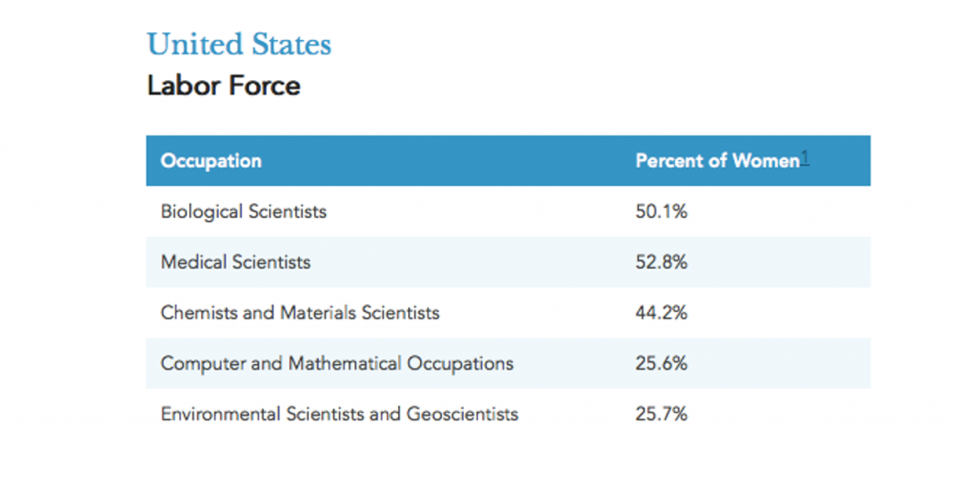I was surprised when a colleague adamantly insisted that I was a woman working in technology. My work includes creating user and customer experiences (UX/CX) and implementing marketing technology systems. It’s definitely more of the softer uses of technology – a far cry from engineering. And I usually work with marketing or product teams.
A different day, I had a conversation with this same colleague about women in technology. I shared with her my theory about how women aren’t as underrepresented in STEM (science, technology, engineering, mathematics) as we are led to believe. I cited a few reasons. She disagreed. She told me that from her experience, most of the women she works with are in marketing or PR; there aren’t many women engineers making products.
I felt it was a conflicting viewpoint and I wondered which was it – am I a woman in STEM or not?
Conversations like this got me to wonder if we are exploring the wrong conversation about women in STEM/technology. Rather than discussing why women are not entering and/or leaving the science and technology fields, maybe we should be discussing which jobs are considered to be technology jobs. In today’s world, we are all dependent on technology and need to understand it to succeed.
Let’s define STEM.
STEM officially represents science, technology, engineering and mathematics. This sounds straightforward enough as a definition, but as you learn more about it, this topic quickly gets complicated.
The report that outlines the need for more women in STEM originated from the US Department of Commerce. At the end of the report, they list the professions included in their study. The list is based on SOC (Standard Occupation Classification) codes. There were a few jobs and fields – that you would expect to see in such a report – missing:
- medical sciences (reason for exclusion: they are part of the National Institute of Health, not officially a science according to the Dept. of Commerce)
- architecture
- accounting
- social sciences (although they are part of the National Science Foundation, they were excluded from consideration)
After a little research, I was disappointed to learn that this report defined STEM jobs based on a profession’s association with government departments. That’s a bit of an arbitrary way to classify careers, especially when society may have a different perception of the work. For example, medical sciences were not considered STEM because they are part of the National Institute of Health. Social Sciences, although part of the National Science Foundation, were excluded. In many ways, sorting the professions this way is definitely not reflective of the type of work that is associated with the jobs.
Secondly, many articles include these four professions, and more, in their discussion of STEM. For 3 of the 4 professions listed, women make up at least 50% of those working in them, except for architecture. Certainly with only 15% licensed women architects, there is work to be done.
A third challenge with the report is the dated nature of the SOC system itself. It’s not clear how jobs in emerging industry areas listed below fit into the older paradigm. There is a possibility that women aren’t associating their jobs with the proper SOC because it is hard to find or it simply does not exist. Here are some professions with gaps:
- Business analysts, UX professionals, or project managers
- Education technologies – designing courseware and how people learn in different areas
- Marketing and sales technologies – social selling, CRM, social media, content marketing and SEO
- Product marketing engineer/manager – depending on the product, this can be highly technical
- Industrial design – wearables, computing and communication devices
With all these questions, I kept wondering if the problem I had with the report lay more with how the Department of Labor defined the technology part of STEM.
Related article: “WOMEN WORLDWIDE ASSERT THEIR POWER THROUGH NECESSITY”
The Technology component of STEM
Determining what it means to be a woman in technology is controversial because of the nature of technology. According to Merriam-Webster, Technology is defined as “the use of science in industry, engineering, etc., to invent useful things or to solve problems.”
That’s a broad definition.
I searched for another definition, something a little more concrete, and I found:
We apply technology in almost everything we do in our lives, we use technology at work, we use it to extract materials, we use technology for communication, transportation, learning, manufacturing, creating artifacts, securing data, scaling businesses and so much more. Technology is human knowledge which involves tools, materials and systems. The application of technology results in artifacts or products. If technology is well applied, it can benefit humans, but if it is wrongly applied, it can cause harm to human beings.
Definition of Technology, Use of Technology
With this broader definition of technology, we could include jobs like designers, administrators, managers, strategists, programmers, and more in operations, marketing, sales, and beyond.
Marketing and sales are traditionally considered to be non-technology professions. However, this perception has changed dramatically over the past 10 years with the accelerated adoption of marketing technologies. Activities like email campaigns, a social media campaign, social selling, optimizing content to support search engines (SEO) or search engine marketing efforts bridge both marketing and IT. Marketers leverage databases and need some basic knowledge of programming and IT to make their visions a reality. Marketing now relies on technology, driven by data, tests, experiments, and results rather than simply nice logos and carefully selected phrases.
According to the Department of Labor in 2015, 43.2% of women are marketing and sales managers and 58.8% of women are market research analysts and marketing specialists. Given that most marketing is digital today, you’d think that this representation distribution would carry over elsewhere.
However, according to the Moz Online Marketing Industry Survey, not so much.
In the Moz study, 30.1% are women digital marketers. This is a gap from the stat that leverages the SOC, which is already a bit flawed because job titles don’t accurately reflect jobs today. However, I wonder if the Moz study respondents truly represent the entire industry, or if they mainly represent Moz readers. In the findings, Moz admits that they are reaching out to participants who are familiar with their site. So is their sample set truly scientific based on who responded? Or is it more a study to understand their subscribers?
I wonder if the challenge with few women in technology is more of a perception and confidence problem?
Apple, Facebook, Google, and the like have less than 35% women on their staff according to their EEO-1 reports.
However, Apple’s issued a statement on their diversity page to prove how diligently they are working on this:
In the past year we hired over 11,000 women globally, which is 65 percent more than in the previous year. In the United States, we hired more than 2,200 Black employees — a 50 percent increase over last year — and 2,700 Hispanic employees, a 66 percent increase…Additionally, in the first 6 months of this year, nearly 50 percent of the people we’ve hired in the United States are women, Black, Hispanic, or Native American.
This statement supports the idea that there are qualified women who can work in a highly competitive technology environment.
So why are the numbers still low? There can be only 2 explanations:
- women aren’t applying because they don’t feel they are qualified or another reason related to their perception
- tech companies simply aren’t hiring women
Apple just shattered shattering the idea that tech companies simply aren’t hiring women, and I think others are soon to follow. I believe that tech companies want to hire women. There are many studies that prove a balanced workplace is best. And if Apple can do what they did, that implies that they are finding qualified women to work in a technology company. So what’s happening?
One possible explanation is that women have a notorious confidence problem. I believe that’s definitely a factor with STEM jobs. If women are told that they aren’t technical because they are “just in marketing” or sales and not an engineer or programmer, they may not perceive their job as having a strong technical component. Although these women may be working in technology every day, they may concede that they truly aren’t very technical due to simple peer pressure.
I worked with 2 marketing directors at a global technology company. Both worked with social media, SEO, marketing automation and marketed technical products. One said she was technical. The other said she wasn’t. And I didn’t witness contradictions like this only once – I find it frequently. And as I wrote in the introduction, I experience this myself.
I’ve observed that women consider themselves and others as working in technology based on how they themselves define technology jobs. It is subjective. Sadly, I think too many of us define technology jobs as only programmer or IT jobs, when these jobs are much broader than that.
For a full mindmap behind this article with articles, videos, and documents see #STEM
What is the distribution of women in STEM overall, anyway?
If we take a closer look at these professions, women are generally represented at about 50%.
—Women in the Sciences, Catalyst
Women are underrepresented in computing, environmental sciences and engineering. But why?
The top five reasons women reported for deciding not to enter engineering were: They were not interested in engineering, didn’t like the engineering culture, had always planned to go into another field, did not find the career flexible enough, or wanted to start their own business. These reasons did not differ significantly across different age groups or years of graduation.
A quarter of the women reported that they left the field to spend more time with their family. Other women reported that they lost interest in engineering or developed interest in another field, they did not like the engineering culture, they did not like engineering tasks, or they were not offered any opportunities for advancement.
—Stemming the Tide: Why Women Leave Engineering
Losing interest in a field could be attributed to how the field is structured or schoolwork not representing the actual field work. Either way, this leads to the possibility that we may be pushing, rather than encouraging, girls and women into a field because they are good at math and science. We aren’t trying to figure out if women even like their career choices.
This thinking could be applied to the low numbers of women in computing as well. Some women don’t like the lonely nature of the field. Programming is a fairly solitary job, and it doesn’t help if a woman programmer is literally the only woman on the team. I agree this needs to be changed – we need to encourage girls to enter the field and mentor more role models. But it’s a chicken-egg problem and definitely not easy to solve.
However, this problem for programming and computer sciences raises the question: is being the only woman on a team a true deterrent to choose and stay in programming? There is always the option to leave and choose to work in a more gender-balanced environment rather than leave the field.
Given the reaction of women once they enter the work world, I wonder if as a society we are truly encouraging girls with talent and promise to pursue a STEM career or if we are pressuring them to pursue a STEM career because they are good at math and science and we need to balance out these statistics.
If so, is this where we really want to be as a society?
The argument to have more women in STEM is valid – we do need gender balance in the workplace. It makes for better products, productivity, and bottom-line results. However, is it right to push girls into a field that they may not really want to work in? Shouldn’t we encourage girls to pursue their dreams and find personal satisfaction doing what they LIKE to do – not simply what they are GOOD at doing?
This leads me to my belief that we are defining STEM too narrowly based on older stereotypes and definitions. Women don’t need to wear lab coats or program computers to work in technology. Women can work in marketing or sales, manage teams, and more. We need to broaden our understanding of technology to see that today everyone needs to understand technology to be successful. It’s not about a few working with it – we all need to work with it.
Until we acknowledge that technology is everywhere, women will continue having confidence problems from the definitions we have imposed upon STEM. There is a STEM club, and women who don’t believe they belong there, won’t consider themselves technologist. And it’s not because they don’t have a degree or are doing the work. It’s because how they define technology.
Recommended Reading: “TECH COMPANIES HELP WOMEN GET BACK TO WORK“
_ _












